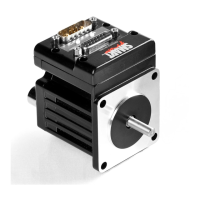Moog Animatics SmartMotor™ Developer's Guide,Rev. L
Page 564 of 909
MFL(distance[,m/s])
Mode Follow, Low Ascend/Descend Rate
APPLICATION: Motion control
DESCRIPTION: Sets the ramp at the low end of the traverse
EXECUTION: Buffered until a G command is issued or either traverse point
after reversal
CONDITIONAL TO: MFR or MSR mode; MFSDC(x,2) mode selected
LIMITATIONS: If the combined ramp slave distances of MFL and MFH exceed
the traverse distance, then the ramp rate(s) are increased as
required.
READ/REPORT: N/A
WRITE: Write only
LANGUAGE ACCESS: N/A
UNITS: Encoder counts from encoder input or internal counter (select-
able)
RANGE OF VALUES: Input:
value: 0 to 2147483647
[m/s]: 0 or 1
TYPICAL VALUES: Input:
value: 0 to 2147483647
[m/s]: 0 or 1
DEFAULT VALUE: 0 (no ramp, follow mode immediately at ratio)
FIRMWARE VERSION: 5.x and later
COMBITRONIC: MFL(1000,1):3
where ":3" is the motor address — use the actual address or a
variable
DETAILED DESCRIPTION:
The MFLspecifiesthe ramp at the low end of the traverse. It uses the format:
MFL(exp1[,exp2])
where:
l
Exp1
Specifies counts — valid value from 0 to 2147483647. Set to 0 (default) to disable.
l
Exp2
(Optional) specifies the meaning of exp1. Values are: 0 specifies input units (master
units); 1 specifies distance-traveled units (slave units).
MFL behaves similar to MFA and MFD — a ramp is defined during the follow profile. However,
MFL is only used in absolute traverse mode, MFSDC(x,2). MFL defines the descent and ascent
Part 2: Commands: MFL(distance[,m/s])

